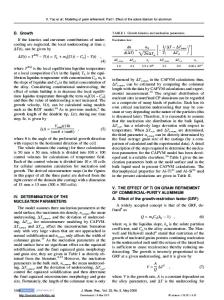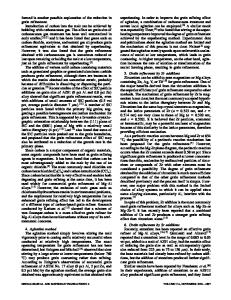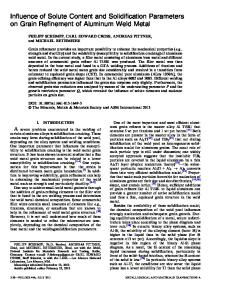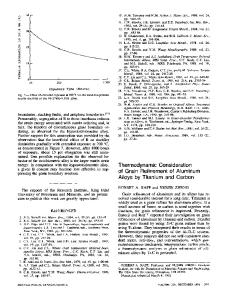Grain refinement of aluminum alloys: Part II. Confirmation of, and a mechanism for, the solute paradigm
- PDF / 1,341,216 Bytes
- 9 Pages / 612 x 792 pts (letter) Page_size
- 22 Downloads / 311 Views
I. INTRODUCTION
PART I of this article described the two paradigms (the nucleant paradigm and the solute paradigm) that have been applied by researchers to explain the mechanism of grain refinement in aluminum alloys. Based on the understanding developed from this review of the literature, a series of experiments were designed to test which of the paradigms is the most applicable and, especially, to determine the nature of the nucleant and the relative effects of solute addition and nucleant concentration. To do this, the following questions, which were stated at the end of Part I, need to be answered. (1) Are TiB2 and the other borides good nucleants? (2) Why is titanium, in excess of the stoichiometric ratio for formation of TiB2, needed? Is it to form Al3Ti, which then is the nucleating substrate for aluminum, or is it needed for its constitutional effects? (3) What is the relative importance of the growth restriction of dendrites by the solute elements and the potency of nucleating particles in grain refining? The experimental work discussed in this article was developed to answer these questions. Based on the results presented here and in the literature, a mechanism for grain refinement is proposed, the details of which need to be determined experimentally. II. EXPERIMENTAL METHOD The alloys studied were based on 99.97 pct pure Al, melted in a clay-graphite crucible by an induction furnace.
The major impurities were silicon and iron. Previous studies[1] which have used super-high-purity aluminium (99.995 pct pure) have obtained similar grain-size results to those reported in this study, because silicon and iron have significantly lower partition coefficients than titanium. Therefore, super-high-purity aluminum was not required for this study. Grain-refining additions were made about 15 minutes before casting and at a temperature near 750 8C to ensure that all Al3Ti particles dissolved. The molten metal was poured into cast-iron block molds with external dimensions of 100 3 100 3 100 mm, with a 70-mm-deep cylindrical cavity of 50 mm in diameter. The mold was heated to 300 8C, and the melt pouring temperature was 750 8C. Combinations of additions from two master alloys were made. One master alloy contained TiB2 particles and Al only, and the other was an Al-6Ti master alloy. Additions were made at addition levels of 0.03, 0.06, and 0.12 wt pct TiB2 and 0.005, 0.01, and 0.02 wt pct Ti. Additions of Al-6Ti and Al-5Ti-B were also made separately to pure aluminum, up to a level of 0.4 wt pct Ti, to observe the behavior of the common grain refiners. The procedure followed was to first alloy the base metal with the TiB2 master alloy and cast it into large ingots. These ingots were then cut into smaller ingots for remelting, with the addition of titanium for final casting into the molds as described earlier. The Al-6Ti master-alloy rod was produced by KB Alloys (USA), while the Al-5Ti-B rod and the Al-3TiB2 waffle plate were supplied by London Scandinavian Metallurgical Co. Ltd, (U.K.). A. Metallography
MARK EASTON,
Data Loading...











